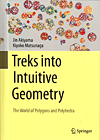- About MAA
- Membership
- MAA Publications
- Periodicals
- Blogs
- MAA Book Series
- MAA Press (an imprint of the AMS)
- MAA Notes
- MAA Reviews
- Mathematical Communication
- Information for Libraries
- Author Resources
- Advertise with MAA
- Meetings
- Competitions
- Programs
- Communities
- MAA Sections
- SIGMAA
- MAA Connect
- Students
- MAA Awards
- Awards Booklets
- Writing Awards
- Teaching Awards
- Service Awards
- Research Awards
- Lecture Awards
- Putnam Competition Individual and Team Winners
- D. E. Shaw Group AMC 8 Awards & Certificates
- Maryam Mirzakhani AMC 10 A Awards & Certificates
- Two Sigma AMC 10 B Awards & Certificates
- Jane Street AMC 12 A Awards & Certificates
- Akamai AMC 12 B Awards & Certificates
- High School Teachers
- News
You are here
Treks into Intuitive Geometry

Publisher:
Springer
Publication Date:
2016
Number of Pages:
425
Format:
Hardcover
Price:
69.99
ISBN:
9784431558415
Category:
General
The Basic Library List Committee suggests that undergraduate mathematics libraries consider this book for acquisition.
[Reviewed by , on ]
Tricia Muldoon Brown
04/8/2016
Treks into Intuitive Geometry is a delightful read covering various topics in geometry, from tilings of the plane to three-dimensional solids. Its narrative is non-traditional, employing a dialog between a student and teacher. Main results are set apart as theorems and propositions, but definitions and examples are embedded within the conversations. This style allows the text to read more like a novel or a play than a textbook, with the clever interactions illuminating the mathematical topics with the ease of reading purely for pleasure.
Each chapter introduces the mathematics with an interesting example or puzzle and follows with the major theorems on the subject. For example, the chapter on cross-sections of polyhedra is introduced with CT scanners and 3-D printers, while a pig puppet that is to be transformed into a ham loaf is used to begin the chapter on reversible polyhedra.
Proofs of results within the chapters are mainly given by “demonstration,” by “observation,” or by “illustration.” The exposition in these proofs is very well done. It guides the reader step-by-step through a logical sequence from the beginning assumptions to the results, often using a concrete example to justify the more general result. However, this book in not without rigor. In the cases where the details may get too technical, complete proofs, along with references, are included in the appendices associated with many chapters.
This book is also filled with wonderful full-color illustrations. As examples, there are diagrams showing the three types of convex hexagons that can tile the plane and detailed figures depicting wrappings of boxes. As artistic examples are often used, there are pictures of artwork, both classical art, such as Salvador Dali’s “The Sacrament of the Last Supper” found in the chapter on platonic solids, as well as modern creations, such as those of the authors depicting reversible figures in the chapter on envelope magic.
The text of Treks into Intuitive Geometry has a very “hands-on” feel as it explores geometric topics in two and three dimensions. With these concrete topics and easy-going style, this book can be enjoyed by mathematicians and recreational puzzlers alike.
Tricia Muldoon Brown (patricia.brown@armstrong.edu) is an Associate Professor at Armstrong State University with an interest in commutative algebra, combinatorics, and recreational mathematics.
See the table of contents in the publisher's webpage.
- Log in to post comments




